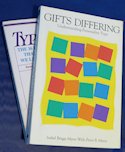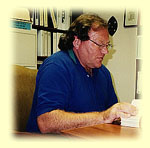
- About the MBTI
- Verify Your MBTI Type
- Personality Patterns
- MBTI Articles & Resources
- Article Directory for Educators & Students
- Books on Personality Types
- Emotional Intelligence & Personality Type
- Career Planning & MBTI
- MBTI Business Applications
- Lenore Thomson - Carl Jung Personality Type
- Site Map - Master Directory of All Articles
- MBTI Consultant Links
- Personality Type Workshops & Conferences
- Links to Other Type Websites
- Murder Mystery Business Theatre
- About Us
Understanding the MBTI ® and Myers Briggs Personality Types
Dynamics of Personality Type
Page 1. Introduction
Page 2. J & P Attitudes
Page 3. Traits &
Mental Processes
The Dynamics of Personality Types: Interpreting the 4 Letter MBTI ® Code of Personality Types
By Ross Reinhold, INTJ
ENTJ, INFP, ISTJ, ENFJ and so on. Many know these are the short-hand designations for the 16 Personality Types popularized by Isabel Myers and her successors fascinated by the theory of personality originally postulated by psychologist Carl Jung. But less well known is that there is an order and organization to these letters code.
The middle two letters of the Myers Briggs Personality Type Code refer to what Isabel Myers and Psychologist Carl Jung called the "mental functions" (Sensing, Intuition, Thinking, and Feeling). These functions or mental processes are divided into two categories: perceiving and judging. The second letter of the personality type code represents the preferred means of perceiving of that personality type. The third letter repesents the preferred means of judging. Although the four letter type code only shows two of these functions or processes, everyone has and uses all four of them. Examples. Those who prefer Intuition (second letter is N) will use or rely upon their Sensing nature in some specialized way - complimenting rather than conflicting with their more preferred Intuition. Those whose preference is Thinking (third letter is T) will value and use its opposite, Feeling, in certain ways and sometimes will let this function be their guide even though normally the person favors Thinking.
Two Kinds of Mental Functions
Sensing (S) and Intuition (N) are considered Perceiving Functions. They are two contrasting ways of taking in information. Thinking (T) and Feeling (F) are considered Judging Functions. They are two contrasting ways of making decisions.
Perceiving and Judging are essential components to all cognitive activity. There can be no Judging without prior Perception; and no Perception without some form of Judging inevitably following. They are hand-in-glove processes. Whatever is a person's most favored Perceiving process combined with whatever is his/her most favored Judging process is at the core of personality and is a major influence in the overall constellation of personality development.
The Dominant Function or Mental Process
One of these two most favored processes takes the lead and is termed the Dominant Function. The other works in a supportive fashion to the dominant and is termed the Auxiliary Function. So while two personality types may share the same two middle letters in the code (For example ESTP and ESTJ), their Dominant and Auxiliary functions can be reversed . . . and thus one reason why there can be marked differences in their respective personality makeup. In the examples, ESTP is Sensing Dominant supported by Thinking Auxiliary; whereas ESTJ is Thinking Dominant supported by Auxiliary Sensing. ESTP prefers the Perceiving half of the ST Perceiving-Judging pair; whereas ESTJ prefers the Judging half of the ST Perceiving-Judging pair.
Hierarchy of Mental Processes
Each of the 16 personality types has a characteristic pattern in the alignment of the four mental functions. This pattern is referred to as a "hierarchy" because they typically differ in the degree of influence on the personality and the degree they are consciously experienced. As indicated above, the most important or influential function is termed the "Dominant" function (#1) and the second most important is termed the "Auxiliary" (#2). The third in the hierarchy is called the "Tertiary" (#3) and is the polar opposite of whatever function is the Auxiliary. The Fourth in order Jung termed the "Inferior" function (#4). It is the mental process with the least conscious awareness and typically the least developed of the four functions. It is the polar opposite of whatever is the Dominant. So if INtuition is Dominant, its opposite - Sensing - is the Inferior or Fourth. If Feeling is Dominant, then its opposite - Thinking - is Inferior or Fourth.
 The rationale for the opposite relationship of the Dominant and the Inferior (fourth function) has to do with energy and the natural polarity of the mental functions. For example, a person with dominant Intuition will direct his/her primary energy to this function - which happens to be in the exact opposite direction of Sensing. It is like trying to go North and South at the same time.
The rationale for the opposite relationship of the Dominant and the Inferior (fourth function) has to do with energy and the natural polarity of the mental functions. For example, a person with dominant Intuition will direct his/her primary energy to this function - which happens to be in the exact opposite direction of Sensing. It is like trying to go North and South at the same time. It is much easier to couple that dominant with either the Auxiliary or Tertiary because these are not polar opposites to the main direction. They are like East and West on the compass. So navigating NW or NE is a natural direction of movement - but North-South is not.
It is much easier to couple that dominant with either the Auxiliary or Tertiary because these are not polar opposites to the main direction. They are like East and West on the compass. So navigating NW or NE is a natural direction of movement - but North-South is not.
At the end of this article is a table showing the first four places in this Hierarchy of Functions for each of the 16 types.
Some students of Personality Type, myself included, are uncomfortable with using Jung's term for the Fourth function: "Inferior." Bear in mind Jung was writing in the 1920's and his works had to be translated from German to English. I bring this up to caution the reader against jumping to conclusions on this Dominant-Inferior pairing. To wit, although a person's dominant function might be Feeling and therefore their inferior function is Thinking, do not presume that their "thinking" is inferior, i.e. defective!! For reasons to be explained later, there is often a built-in growth dynamic to consciously develop whatever is opposite one's dominant mental function.
Attitude is Also Important - the first letter in the code of Personality Types
Here's another Jungian term that carries a somewhat different meaning in the 2006 English speaking world. We don't mean your world view or the rosyness of your outlook. It isn't like "Lose the attitude, Dude!"
Just as the oppositeness of the mental functions can be comprehended by using the analogy of the four points of a compass (N/S, E/W), Jung's Attitudes are a navigational concept. It has to do with orientation. Here again, we encounter opposites. Jung coined the terms Extraversion and Introversion to refer to the two polar opposite directions of psychic attention and energy. He found that whatever was a person's dominant mental function was directed to either the external world (E) or the internal world (I). This preference in attitude of the dominant function is a major distinguishing feature in personality type patterns. So while ISTP and ESTJ both have Thinking as their dominant function, the former prefers to direct it inward whereas the latter directs it outward. The result is quite different styles of personality.
This energy preference for the dominant function is denoted by the first letter in the Myers-Briggs Type Code.
Jung had no shorthand code for his "psychological types." He described the various types but did not present or order them in the kind of organized fashion that Myers instituted.
Here is a table of the types using Jung's terminology with the MBTI equivalent in parenthesis:
Introverted Types |
Extraverted Types |
| Introverted Intuition with Thinking (intj) | Extraverted Intuition with Thinking (entp) |
| Introverted Intuition with Feeling (infj) | Extraverted Intuition with Feeling (enfp) |
| Introverted Sensing with Thinking (istj) | Extraverted Sensing with Thinking (estp) |
| Introverted Sensing with Feeling (isfj) | Extraverted Sensing with Feeling (esfp) |
| Introverted Thinking with Intuition (intp) | Extraverted Thinking with Intuition (entj) |
| Introverted Thinking with Sensing (istp) | Extraverted Thinking with Sensing (estj) |
| Introverted Feeling with Intuition (infp) | Extraverted Feeling with Intuition (enfj) |
| Introverted Feeling with Sensing (isfp) | Extraverted Feeling with Sensing (esfj) |
![]() Next: Understanding the Myers-Briggs letters J and P
Next: Understanding the Myers-Briggs letters J and P
Other Popular or New Articles on Personality Type
![]() Mobile Friendly Version of our Free Personality Type Test
Mobile Friendly Version of our Free Personality Type Test
The Civil War between Feeling and Thinking

Trump - The Mouth that Roared Once Too Often?

® MBTI, Myers-Briggs, Meyers Briggs, and Myers-Briggs Type Indicator are registered trademarks or trademarks of the Myers-Briggs Type Indicator Trust in the United States and other countries (aka meyers briggs or myers briggs).
|
The MBTI Personality Type of Donald Trump - looking behind the media mask of The Donald.
© Published by Ross Reinhold & Reinhold Development 1997 - 2023
Privacy Policy About Us


